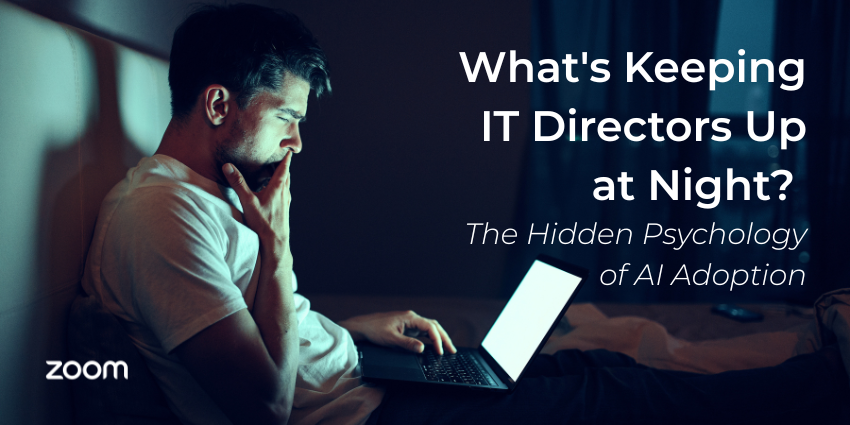It’s 3:17 AM, and across the globe, IT Directors are wide awake, scrolling through compliance reports, flagging AI-assisted decisions that lack proper documentation. The haunting question: “What happens when auditors ask us to explain how our AI made a recommendation that affected high-stakes decisions?”
These technology leaders aren’t alone. Across industries, IT Directors face sleepless nights filled with AI-related concerns—not excitement-driven wakeful hours, but anxiety-driven questions with no easy answers.
The Integration Nightmare
The promise of AI was simplification, but reality has become increasingly complex. Organizations now manage multiple AI tools—ChatGPT for content creation, Claude for document analysis, Microsoft Copilot for Office integration, Jasper for marketing—while collaboration sprawls across different messaging platforms and video conferencing systems.
Furthermore, many of these tools aren’t configurable to businesses’ individual needs. Organizations need tools that are adaptable and tailored to their functional requirements.
IT leaders express frustration over AI tool fragmentation and lack of flexibility: “We’ve accidentally created tool silos. Each department picked its favorite solutions. Now we have dozens of platforms that don’t talk to each other. Teams spend more time managing integrations than benefiting from these capabilities.”
Context gets lost as information moves between systems, decisions become fragmented, and intelligent automation turns into an administrative burden.
The Trust Deficit
Beyond integration lies a deeper concern: the black box problem. AI systems can make recommendations affecting everything from hiring to customer service, but many lack the transparency required for business accountability.
“I need to explain why our AI suggested prioritizing one support ticket over another. When the AI says ‘trust me’ but won’t show its work, I’m left holding the bag when things go wrong,” notes one IT Director.
This “AI trust deficit” creates bottlenecked workflows in which AI acceleration is neutralized by human hesitation. Regulated industries face particular challenges when AI decisions affect financial, healthcare, or employment outcomes.
The Human Factor
Perhaps the most complex challenge isn’t technical—it’s human. Implementing AI means navigating employee fears and resistance to change, and balancing automation with human value.
“My biggest challenge isn’t configuring the AI—it’s helping experienced employees understand that AI won’t replace them, but will change how they work. Some days I feel more like a therapist than a technologist.”
Traditional change management approaches often fail with AI implementation. Unlike predictable software, AI systems evolve and learn, creating moving targets for training programs.
The Solution: Contextual Intelligence
Though the challenges are complex, the solution doesn’t have to be. AI-first tools, such as Zoom AI Companion, help address these challenges through “contextual intelligence”—AI that understands individual requests within a broader business context.
“At Zoom, we’re seeing a fundamental shift in how IT departments operate with AI at their core,” said Dharmesh Panchmatia, head of IT Enterprise Applications & Shared Services at Zoom. “The intelligence-first approach means moving from reactive troubleshooting to proactive system optimization through AI and machine learning capabilities.”
Zoom tackles integration nightmares by consolidating AI capabilities within a single collaboration environment through Zoom AI Companion and integrations with supported third-party apps, bringing the most important information onto a single pane of glass. AI-generated meeting summaries automatically generate tasks for participants and inform project documents, chat conversations provide context for AI suggestions, and document collaboration feeds into meeting preparation and follow-up, all within Zoom Workplace.
For transparency, Zoom AI Companion is designed to provide grounded responses and citations that help show its reasoning. When suggesting meeting agendas, it cites its sources and explains which previous meetings, documents, and conversations informed recommendations. This explainability helps build necessary trust.
Additionally, Zoom does not use any customer audio, video, chat, screen sharing, attachments, or other communications like customer content (such as poll results, whiteboard, and reactions) to train Zoom’s or its third-party artificial intelligence models.
Cultural change gets addressed when intelligence emerges naturally within familiar workflows rather than requiring dramatic behavioral changes. Team members don’t learn new interfaces; AI capabilities appear as helpful enhancements to existing collaboration patterns.
From Anxiety to Advantage
The transformation requires recognizing that workplace intelligence isn’t about replacing human decision-making—it’s about enhancing human collaboration with contextual, transparent, and integrated AI capabilities.
“IT leaders need to completely rethink their team structure,” noted Panchmatia. “Organizations need to prioritize AI literacy across all IT functions while building robust data platforms that can support both traditional analytics and advanced AI models. It’s about creating an environment where AI augments human decision-making rather than replacing it.”
As one healthcare IT Director reflects: “Six months ago, I was losing sleep over AI compliance risks. Now I sleep better knowing our AI decisions are explainable, our teams are adapting gradually, and our intelligence platform grows smarter as our collaboration deepens.”
Organizations succeeding with AI aren’t those with the most advanced algorithms or the biggest budgets. They’re the ones recognizing workplace intelligence as a collaboration challenge, not just technology implementation.
“The key to success in this transformation is maintaining a strong focus on ethical AI implementation while ensuring these initiatives deliver real business value,” said Panchmatia. “It’s not about implementing AI for AI’s sake—it’s about solving concrete problems and improving operational efficiency.”
The 3 AM wake-up calls are becoming less frequent. IT Directors are sleeping better, knowing their AI implementations are built on solid foundations of transparency, integration, and human-centered design. The age of intelligence has arrived—and it looks more collaborative than anyone expected.
Watch our new webinar: Five Modern Workplace Trends and get practical insights on how you can implement and use AI.







